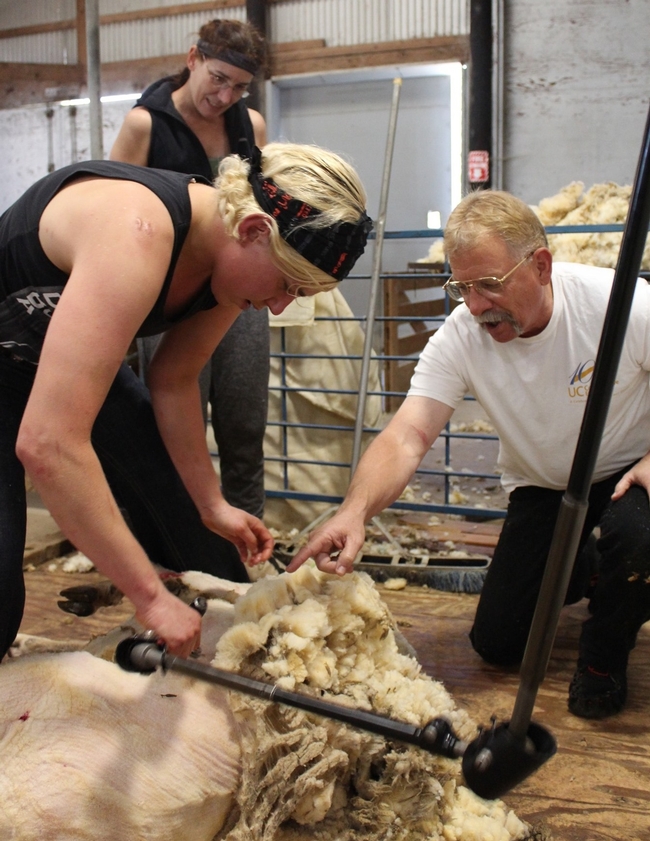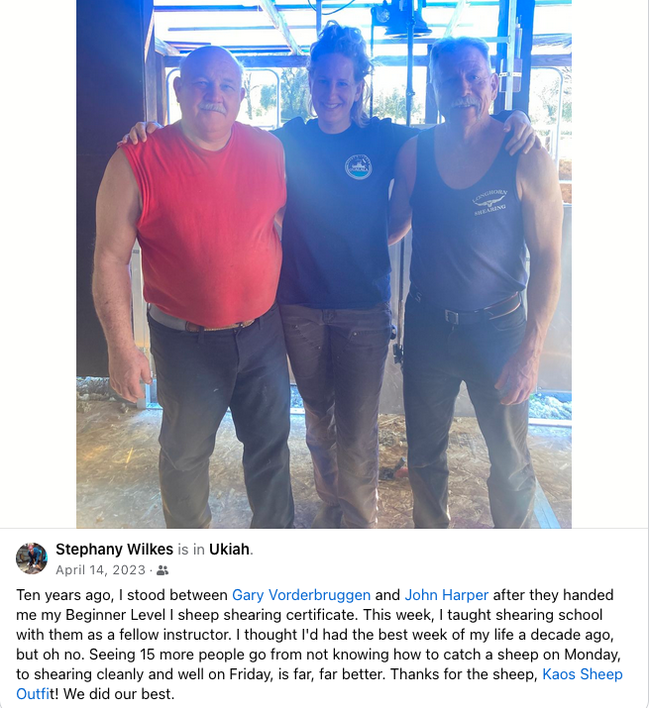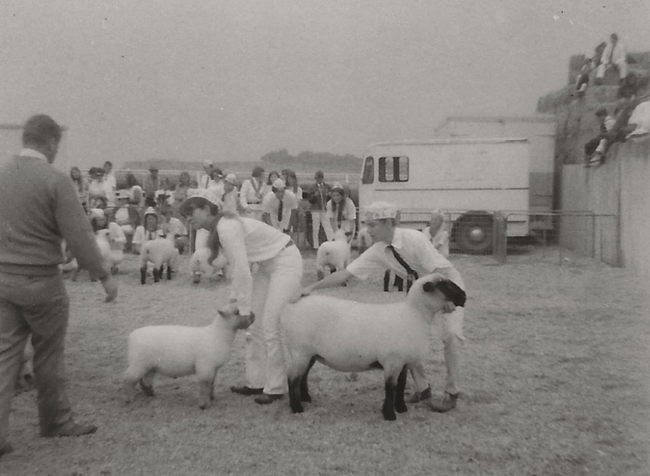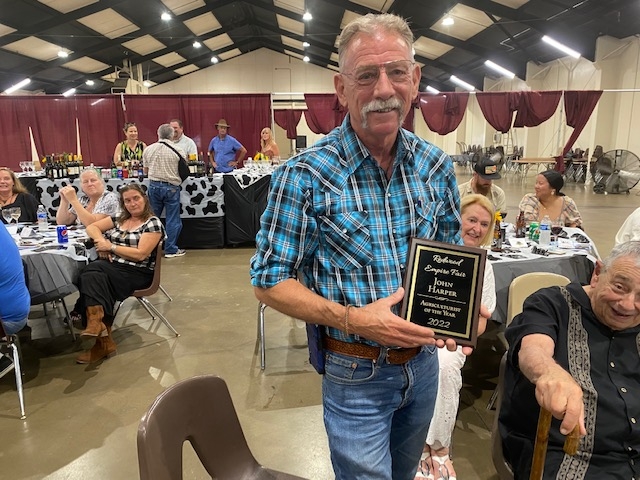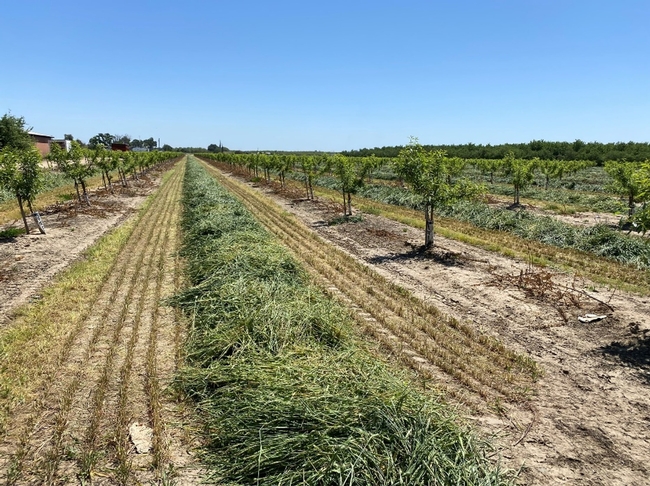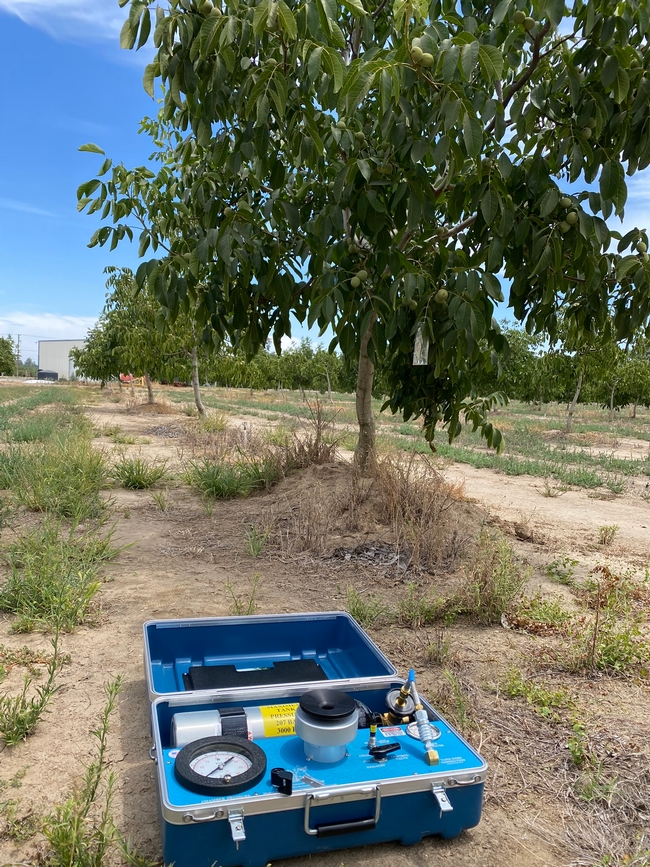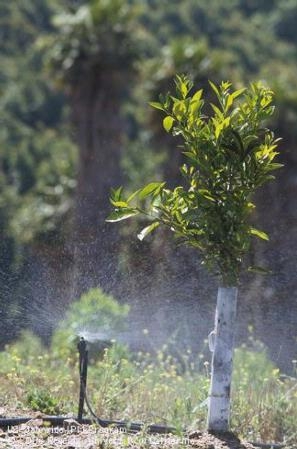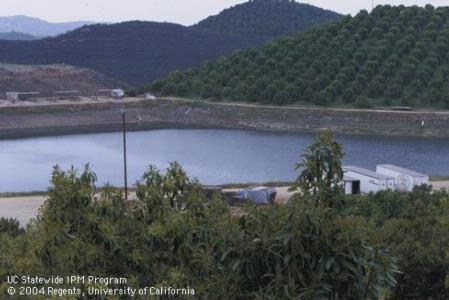Posts Tagged: water-use
Shearing students, ranchers flock to livestock advisor Harper
UCCE livestock advisor John Harper retires after 32 years
"If you know how to shear, you'll never be poor," Stephany Wilkes remembers John Harper, University of California Cooperative Extension livestock and natural resources advisor for Mendocino and Lake counties, telling her sheep shearing class in 2013.
“He was speaking to everyone, of course, but he really spoke to me: being poor (again) is one of my greatest fears and I've avoided it at all costs,” Wilkes said. Harper's words and a certificate from the course gave her the confidence to leave Silicon Valley for greener pastures.
“Eleven years later, with a successful business and published book about shearing to boot, I can confirm John does not lie to his students,” says the former software developer. “More than that, he is encouraging, calm, respectful, experienced, honest, funny and an excellent storyteller. If not for John, I would not have the life I live today.”
Today, Wilkes is a sheep shearer, knitter and author of “Raw Material: Working Wool In the West.”
Harper officially retired July 1, 2023, after 32 years in his UC Cooperative Extension advisor role, but returned to serve as interim director of UCCE for Mendocino and Lake counties until Matthew Barnes was hired on May 1.
For years, UCCE has offered the only five-day sheep shearing school in California, training 15 to 28 students annually, and Harper has been the force behind it.
“Most of the shearers now in the shearing business in California were trained by me and my fellow instructors,” said Harper, the state's Ed Sheeran of sheep shearing.
He first offered the sheep shearing school in 1993 at the Paul and Kathy Lewis ranch in Upper Lake, with subsequent schools at the Stanley Johnson ranch in Booneville. In the early days, Harper brought in instructors from New Zealand, before he and Mike McWilliams, a former member of the USA Sheep Shearing Team, began teaching. Later Harper moved the school to UC Hopland Research and Extension Center, where he has hosted the school for the past 27 years.
With grant funds from the National Sheep Industry Improvement Association, Harper bought shearing equipment and made seven portable shearing pens to offer shearing school at a private ranch in Clear Lake Oaks this year.
“This program is nationally and internationally known and there is a waiting list of over 1,000 people who want to take it,” Harper said.
Harper's baa-ackground in 4-H
Growing up on his family's farm in Yucaipa, just east of San Bernardino, Harper's electrical engineer father gave him a choice between caring for the horses' hooves and shearing sheep. “I chose shearing since I wasn't very big and didn't like horses leaning on me,” he said.
From age 9 to 19, he was active in the California 4-H Youth Development Program, achieving the Gold Star rank. “I was in 4-H with sheep, horses, veterinary medicine, tractor, electrical, welding and woodworking projects,” said Harper, who won the outstanding junior leader award. “I was a junior leader in sheep and won the state award for my sheep project. I showed registered Hampshire sheep, and my flock grew to 50 ewes before I was done.”
“Shearing sheep helped me pay for college,” said Harper, who earned a master's degree in range management at the University of Arizona and a bachelor's degree in animal science and agricultural economics at UC Davis.
After college, Harper worked as an assistant manager on the PolyPay breed development at Nicolas Sheep Farms in Sonoma before starting a career in Cooperative Extension in Arizona.
When Harper joined UC Agriculture and Natural Resources in 1991, the internet was in its infancy, but he recognized its potential for sharing information. He learned how to write code and created the university's first websites for livestock and natural resources. He also was an early adopter of blogging, Facebook, LinkedIn and Twitter to extend information, which earned him a silver award in 2011 from the Association of Natural Resources Extension Professionals.
Beyond shearing, Harper pioneered cutting-edge research
Although sheep are more photogenic on social media, Harper has been flooded with awards and accolades for his water quality research.
Informed by research from Harper, Lake County rancher Russ Rustici created the first rangeland water-quality ranch plan in the state. Rustici was so pleased that he donated research funding for the entire UC Rangeland Watershed Program team and later established two endowed chairs at UC Davis and one at UC Berkeley. The Rustici Endowment now provides research and education grants for rangeland and cattle efforts.
In 1995, Harper and his UCCE colleagues began teaching the Rangeland Water Quality Planning Short Course to help land managers develop water-quality management plans for their ranches to prevent water pollution. By 2015, they had taught more than 80 of these short courses, reaching more than 1,000 ranchers in 35 counties, representing over 2 million acres statewide. In one follow-up survey, 68% of the participants said they had implemented practices on their ranches to protect or improve water quality.
In 2012, the Western Extension Directors Association presented Harper with its Award of Excellence for the Rangeland Watershed Program.
Eating between the vines
For one livestock research project, he and UCCE colleagues trained sheep to graze the grass in vineyards and not eat the grapevines. “The results went viral internationally and really brought targeted grazing to the forefront,” Harper said. “It also raised sheep number by 2% in our two counties.”
In addition to advising ranchers and teaching sheep shearing, Harper has served in several leadership positions, rotating in every few years as UCCE director in Mendocino and Lake counties. From 2014 to 2017, he led UC ANR's Sustainable Natural Ecosystems Strategic Initiative, advocating for the hiring of experts in climate change, economics, small ruminants, forestry and fire.
“I'm especially proud that we were able to recruit a small ruminant extension veterinary specialist – a position that was unfilled for over seven years, despite California being the second-largest sheep-producing state in the nation,” Harper said.
The certified rangeland manager and rangeland professional has long been a member of the Society for Range Management and the American Society for Animal Science. In 2008, he served as president of the California-Pacific Section of the Society for Range Management. Currently he is the secretary/treasurer for the Mendocino/Lake Wool Growers Association and is ad hoc director of the Mendocino/Lake County Cattlemen's Association.
In 2015, the Society for Range Management gave him the Outstanding Achievement Award-Stewardship. In 2017, the California Wool Growers Association bestowed on him its Golden Fleece Award for Lifetime Achievement. In 2019, Harper was named Range Manager of the Year by the California-Pacific Section of the Society for Range Management for his contributions to the profession. In 2022, the 12th District Agricultural Association Redwood Empire Fair honored him with their Mendocino County Agriculturalist of the Year Award.
Harper also received UC Agriculture and Natural Resources' prestigious emeritus status. In retirement, he plans to play his banjo and continue offering the sheep shearing school with GaryVorderbuggen, who has been teaching with him for 18 years. Randy Helms, a former member of the USA Sheep Shearing Team, and Harper's former students Matt Gilbert, Lora Kinkade and Wilkes are among those who have re-ewe-nited with him as sheep shearing instructors.
“John taught the UCCE sheep shearing schools I attended in 2013-2015, and I was deeply honored to teach beside him in 2023 and 2024. It is one of the highlights of my life,” said Wilkes, now better known for working with wool than developing software.
“Like so many past students, I am forever in his debt,” she added. “We've got to keep this shearing school you started going, John. It is a gift. Thank you.”
Report: Wastewater recycling essential to resilient water future for LA region
Wastewater recycling in Los Angeles is the focus of a new report released by the UCLA Luskin Center for Innovation and the UC Agriculture and Natural Resources. The report, Making the Most of Landmark Recycled Water Investments in Los Angeles: Technical Advisory Recommendations for the Region, was commissioned by Los Angeles Waterkeeper. The goal of the report is to support ongoing efforts to improve local water security and rely less on expensive, energy-intensive and increasingly unreliable water imports from faraway places, like the Sacramento-San Joaquin Delta and the Colorado River.
Experts involved in developing the report agree that expanding the use of recycled wastewater has emerged as a key, scalable water supply strategy that can offer certainty and reliability in the region in light of our new climate reality.
“Both the Metropolitan Water District of Southern California and the City of LA's Department of Water and Power have made significant investments in wastewater recycling, and they plan to do more,” said Bruce Reznik, executive director of LA Waterkeeper. “But there are a lot of moving parts and some critical decisions to be made in the short term if we're going to make significant progress toward reliable local water supplies.”
“The purpose of this report is to help decisionmakers see the full picture so they can prioritize and develop informed strategies for expanding and integrating the disparate wastewater recycling projects into a more cohesive wastewater system – all while taking community voices and environmental impacts into account,” he added.
Local leaders recognize the region must further invest in equitable, climate-smart, affordable local water strategies. LA County's Water Plan, released in late 2023, calls for 80% of water to come from local sources by 2045 (compared with approximately 40% currently). Four major centralized wastewater recycling projects, including two that are landmark in size and scope, have either broken ground or are in the active planning stages throughout Los Angeles County. Collectively, this regional effort may represent the most important water supply investment in the American West in the last half century.
“In many ways, our region has taken great strides toward embracing wastewater recycling,” said report co-author Edith B. de Guzman, UC Cooperative Extension water equity and adaptation policy specialist. “But we need a clearer pathway for how these projects can be built and possibly integrated into a more cohesive system. This report provides a blueprint for water agencies on the project design, community engagement and governance steps that must be made to ensure progress toward rapidly increasing our local water independence.”
Upwards of $20 billion in investment in wastewater recycling projects is planned for the coming years. But as local water and wastewater agencies make these investments, it's essential that they design systems to both maximize benefits and minimize impacts that could be damaging to people and the environment, all while ensuring water remains affordable. Just as importantly, the report flagged the need to effectively engage the public in key decisions to foster public trust in these emerging water technologies and facilitate coordination between agencies to create a resilient regional water supply system.
Specific action items identified in the report are organized under eight principal recommendations:
- Take actionable steps on current key decision points pertaining to major recycling facilities. The report encourages agencies to make several decisions that will impact the design of the overall wastewater recycling systems imminently. These include resolving differences between the City of LA's Hyperion 2035 and Operation NEXT efforts, deciding whether to upgrade existing wastewater recycling infrastructure like the Edward C. Little Water Recycling Facility, and making key pipeline and routing decisions.
- Conduct a more nuanced regional analysis of system facilities, with an emphasis on evaluating distributed alternatives. While some assessment of a more distributed system has been undertaken, additional analysis is still needed on the issues of energy demand, the cost of distributing water under different alternatives, and impacts on aquatic and marine ecosystems.
- Identify and establish a structure for collaborative governance that enables agencies to work together to realize a regional advanced wastewater recycling network.
- Adopt a coordinated monitoring plan to ensure water quality is safeguarded for public and ecological health.
- Balance the adoption of Indirect Potable Reuse (IPR) and Direct Potable Reuse (DPR) with a near-term focus on IPR to the extent feasible and using DPR to fill in service gaps.
- Perform robust regional forecast and impact analyses to improve future-proofing of facility and network designs, maximize benefits, minimize harm, and avoid stranded assets.
- Design and execute a collaborative communication and community engagement strategy that offers a clear narrative, emphasizes the benefits of a secure water supply, meets the needs of water customers, and is delivered by trusted messengers.
- Coordinate across agencies on strategies to attract project financing while taking household affordability into account.
“This report is by no means the final word,” said co-author Gregory Pierce, research and co-executive director at UCLA Luskin Center for Innovation. “The point of this study is to provide guidance and spur discussion, and we hope and expect to see ongoing research and coordination on all of these issues.”
The report was informed by input from a Technical Advisory Committee of 20 people from fields including academia and think tanks, conservation advocacy, labor, the private sector, and current and former water district leaders not affiliated with the projects that are the focus of the report. This effort also benefited from the feedback and insight of more than 20 public agency representatives, including many from the City of Los Angeles (including Los Angeles Department of Water and Power and LA Sanitation and Environment), Metropolitan Water District of Southern California, Los Angeles County Sanitation Districts, Las Virgenes Municipal Water District, and West Basin Municipal Water District.
The full report is available at https://innovation.luskin.ucla.edu/wp-content/uploads/2024/06/Making-the-Most-of-Landmark-Recycled-Water-Investments-in-LA.pdf.
The Water Girls
If you're struggling with triple-digit temperatures, think about the honey bees. They need to collect water for their colony to cool the hive so their brood can develop. And for other purposes. Just call them "The Water Girls." Lately the bees have...
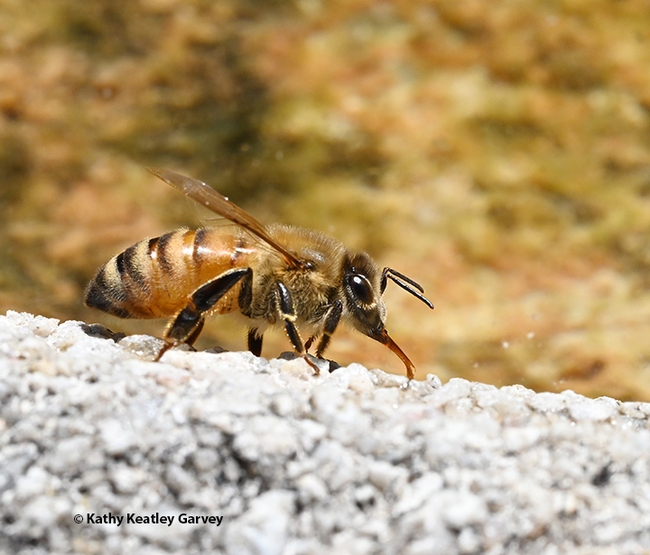
A honey bee, its proboscis extended, collects water from the edges of a birdbath. (Photo by Kathy Keatley Garvey)
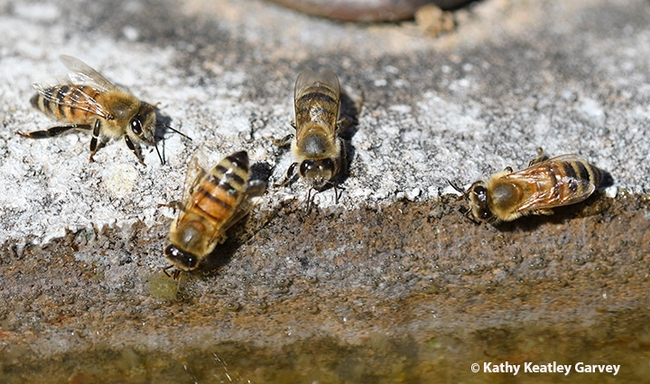
For worker bees: Two's company, three's a crowd, and four is a work party. Bees collecting water from a birdbath. (Photo by Kathy Keatley Garvey)
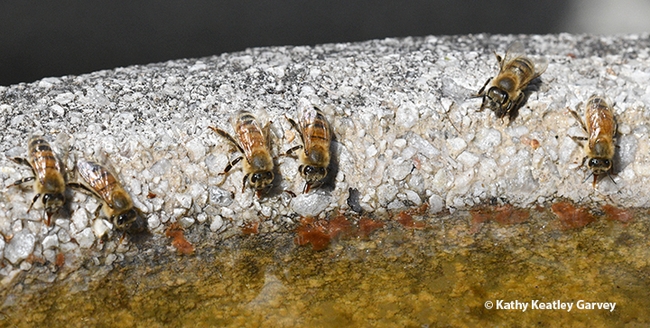
'The Water Girls'--six of them--collecting water at a Vacaville birdbath. Note the absence of birds. (Photo by Kathy Keatley Garvey)
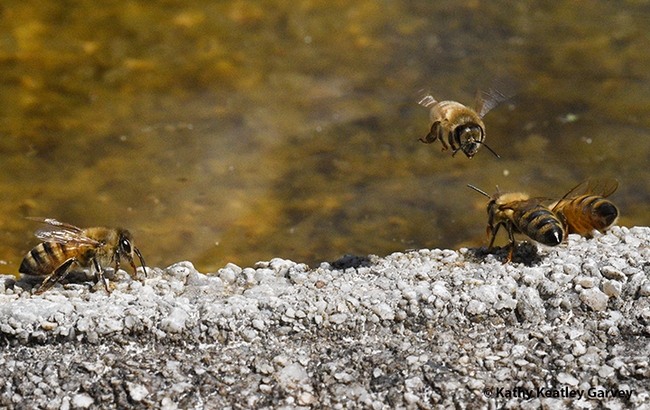
A honey bee heading back to her colony after collecting water to cool down the hive. (Photo by Kathy Keatley Garvey)
Young orchard water and nutrient management workshops offered in Modesto, Merced, Fresno, Bakersfield
Growers invited to discuss young almonds, pistachios, walnuts, olives and citrus orchards starting May 9
To help growers manage irrigation and nutrients for young and immature orchards, UC Cooperative Extension is offering workshops in Modesto, Merced, Fresno and Bakersfield.
The workshops will feature presentations by various experts and researchers focusing on best irrigation and nutrient management practices tailored specifically for young orchards in the San Joaquin Valley. They will cover almonds, pistachios, walnuts, olives and citrus.
“Attendees will gain insights into the irrigation and nutrient needs of young orchards, which are different from those applicable to mature orchards, and learn strategies for adjusting these practices as orchards mature,” said Moneim Mohamed, UC Cooperative Extension irrigation and soils advisor for Stanislaus, San Joaquin and Merced counties. “This knowledge aims to ensure healthier tree development, better resource use and more resilient orchards in the face of climate change.”
Growers, certified crop advisers and other agricultural professionals are encouraged to attend. Workshop attendees may request one-on-one assistance from a UCCE farm advisor.
Speakers include UCCE advisors Mohamed, Mae Culumber, Tobias Oker, and Cameron Zuber, UCCE specialist Giulia Marino, Andre Daccache of UC Davis, Charles Hillyer and Shawn Ashkan of Fresno State.
The Young Orchard Irrigation and Nutrient Management workshops will be held in four locations:
Modesto
May 9 (8 a.m.–12:30 p.m.)
UC Cooperative Extension, Room HI, 3800 Cornucopia Way
Register at https://ucanr.edu/orchardsmodesto
Merced
May 14 (8 a.m.–12:30 p.m.)
UC Cooperative Extension, 2145 Wardrobe Avenue
Register at https://ucanr.edu/orcharsmerced
Fresno
May 22 (8 a.m.–12:30 p.m.)
Fresno State, 5370 N. Chestnut M/S OF 18
Register at https://ucanr.edu/orchardsfresno
Bakersfield
June 5 (8 a.m.–12:30 p.m.)
UC Cooperative Extension, 1031 South Mount Vernon Avenue
Register at https://ucanr.edu/orchardsbakersfield
Workshops are free and include coffee breaks, lunch, workshop materials along with the presentations. Registration is required.
These workshops are supported by a grant from California Department of Food and Agriculture and sponsored by Almond Board of California, California Pistachio Research Board, WiseConn Engineering and Irrometer Company, Inc.
Sewage to Sustenance
- UC Riverside, Senior Public Information Officer
Plant materials that would otherwise become trash may be the key to solving two big problems: diminishing freshwater supplies for farms and diminishing effectiveness of antibiotics.
On average, agriculture accounts for 70% of global freshwater use. In California, which produces nearly half of all U.S.-grown fruits, nuts, and vegetables, that number rises to 80%.
The United Nations estimates food production will need to double by 2050. However, water supplies will not increase accordingly. Instead, due to climate change and drought, water resources are quickly shrinking.
One solution to the increasing need for farm water is to use treated municipal wastewater. There are roughly 16,000 wastewater treatment plants in the U.S., each of them capable of processing up to 10 million gallons every day.
“It's a huge amount of processed water that's mostly clean and can be used again, but there's a problem,” said Ananda Bhattacharjee, assistant project scientist at the U.S. Department of Agriculture's Salinity Laboratory, based at UC Riverside.
“This water can contain chemicals of emerging concern, like antibiotics, that are difficult to detect and treat without advanced and expensive instrumentation,” he said. “These instruments also require trained laboratory personnel to operate and maintain.”
Once exposed to the antibiotics in the water supply, soil bacteria immediately start developing resistance to the drugs because they want to survive. “Bacteria are amazing biological sensors,” he said. As the bacteria develop resistance, antibiotics stop working.
Once crops are irrigated with contaminated reclaimed water, plants that get harvested and come to our dinner tables may contain residual antibiotics, resistance genes, and resistant bacteria.
To correct this issue, Bhattacharjee is leading a new, $1 million project testing a low-cost technology to make the reclaimed water safer for agricultural re-use. Funded by the USDA's Agriculture and Food Research Initiative, the project will test how effectively biochar made from various types of discarded plant materials can “polish” the water.
Biochar is a charcoal-like substance made by burning organic material. Burning any organic matter, even wood chips, in limited-oxygen environments retains the mass of the burned substance. The remaining, charred substance is highly absorbent.
“It's like activated charcoal used in HEPA filters and HVAC systems. Biochar works on the same principal; it adsorbs chemicals present in reclaimed water and allows only clean water to pass through,” Bhattacharjee said.
Based on this principle, Daniel Ashworth, a soil scientist at the Salinity Laboratory, first built a bench-scale filtration system with biochar for the removal of antibiotics in synthetic wastewater. The results were very promising, with antibiotics removal efficiency of up to 98%.
“Encouraged by Dr. Ashworth's experiments, we will be designing the larger-scale biochar-based polishing systems for removing residual antibiotics in reclaimed water,” Bhattacharjee said.
Using biochar polishers could potentially remove the need to detect the antibiotics in reclaimed water, assisting treatment plants that do not have advanced detection or treatment technologies, and cannot afford them.
Affordability is one of the best features of the biochar system. “As engineers, we try to keep it simple. If we can build something for a dime, we don't want to have to spend a dollar,” Bhattacharjee said.
For this project, scientists from UC Riverside, the U.S. Department of Agriculture, US Salinity Laboratory, and the University of California's Agriculture and Natural Resources are teaming up to test biochar made from multiple kinds of plant materials left over from agricultural field production.
To start, they'll collect treated sewage sludge and plant materials such as pistachio shells and date palm leaves which would otherwise be thrown away. These materials will be turned into biochar for designing filtration systems that reclaimed water can pass through.
Ultimately, the team would like to develop a database of different, inexpensive biochar materials that can all be used for removing harmful compounds from reclaimed water for agricultural reuse, especially crop irrigation.
If the costs remain low and effectiveness remains high, the research team hopes growers will install biochar-based reclaimed water polishing systems on their farms. “That is the major goal of the project, taking this from bench scale to full field scale,” Bhattacharjee said.
Right now, the whole ecology of fields is changing due to residual antibiotics in irrigation systems. The reclaimed water gets into the soil, earthworms feed on organic matter in the soil, and they develop antibiotic resistance in their guts. Then they may release this resistance through their feces, making additional changes to soil microflora, which keeps the cycle of resistance going.
“We are slowly spiking our own agricultural fields with this resistance,” Bhattacharjee said. “Demonstrating this issue was our first project, Bacteria Wars: episode one. Now we have a technique to remove the antibiotics and resistant bacteria, reducing the antimicrobial resistance spread in agriculture. This is our episode two: Researchers Strike Back.”
subscribe to the Topics in Subtropics blog: https://ucanr.edu/blogs/blogcore/subscribe.cfm

